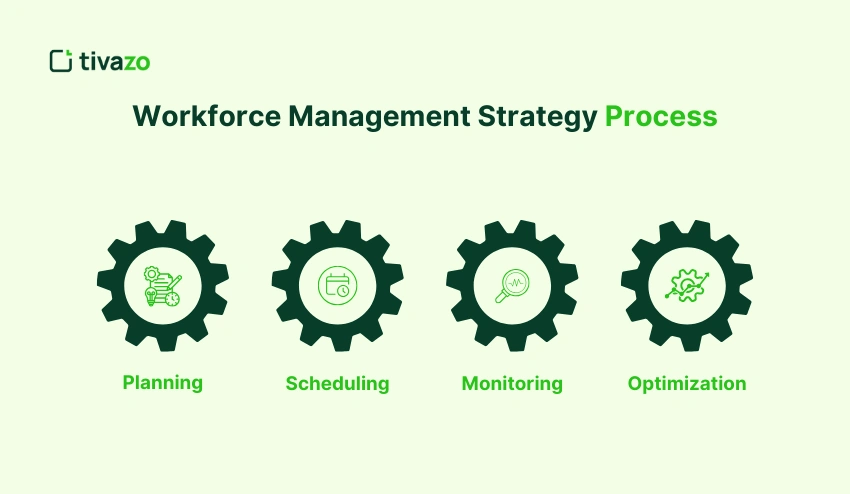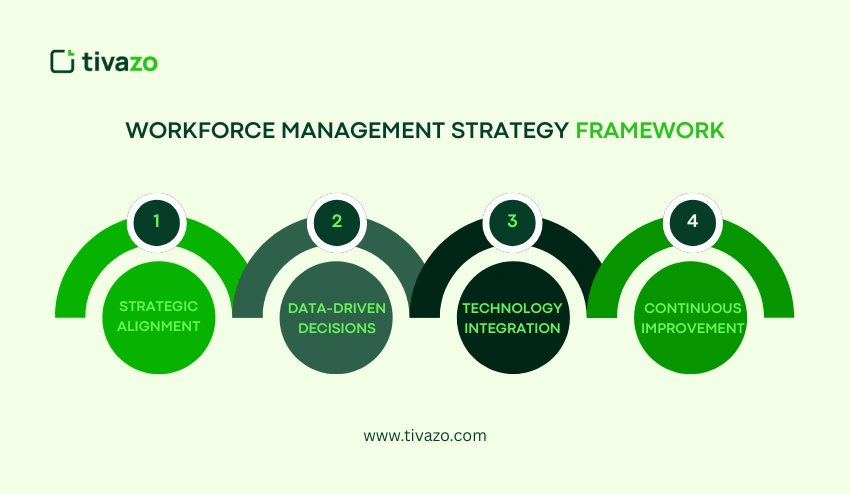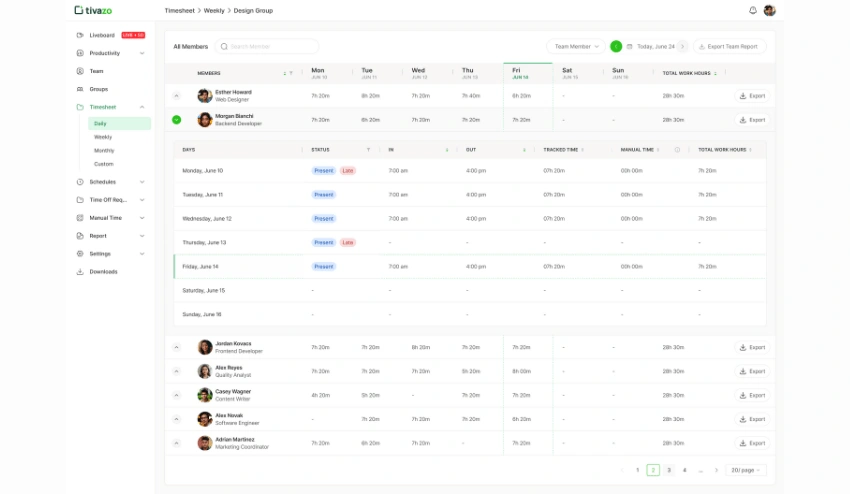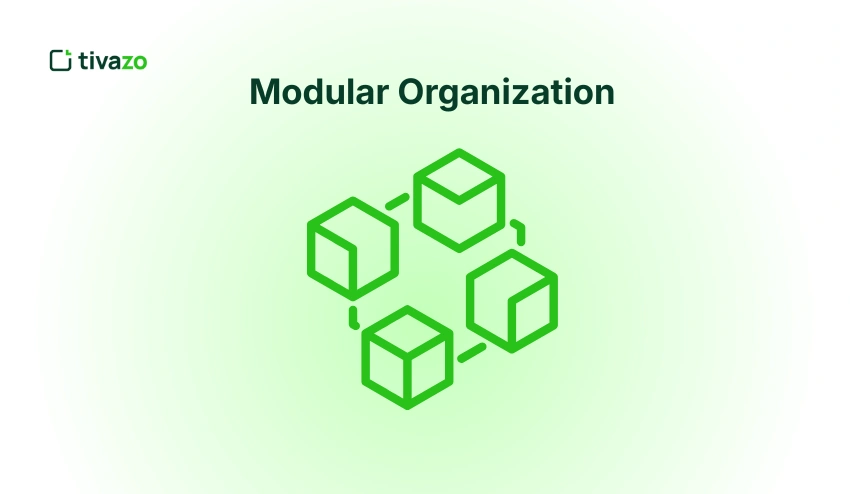Imagine running a business where every employee’s skills, schedules, and performance perfectly align with your organizational goals—productivity soars, costs drop, and your team feels motivated every day.
This is not wishful thinking. A well-thought-out workforce management strategy is what can help turn workforce issues into opportunities. In its absence, businesses are known to be riddled with inefficiencies, employees lacking engagement, and the failure to achieve growth targets.
Designing a workforce management plan that delivers is more than simply setting shifts or keeping track of hours; it is a calculated plan of action that positions the right talent in the right position at the right time with the right abilities. By examining the existing potential of the workforce, planning future requirements, and incorporating the latest tools, a robust workforce management strategy can assist an organization in making informed decisions, enhancing efficiency, and sustaining a highly motivated, high-performance workforce. Learning how to do this, companies will be able to remain competitive in a competitive market and facilitate long-term development.
What Is a Workforce Management Strategy?
A workforce management strategy is a structured approach that organizations use to optimize the productivity, efficiency, and engagement of their employees while aligning workforce planning with business goals. It involves scheduling, assignment of tasks, performance tracking, and compliance to make sure the right individuals are in the right positions at the right time.
In highly competitive economies such as New York, London, or Singapore, a localized workforce management strategy is effective to manage local workforce issues, labor regulations, and labor requirements so that the business can effectively meet its operational needs and employee satisfaction. With the help of technology, analytics, and best practices, a company can employ a workforce management strategy that will help it minimize expenses, enhance performance, and improve its competitiveness both locally and globally.
What Is a Contingent Workforce Management Strategy?
The contingent workforce management strategy is a unique method of managing the temporary, freelance, and contract staff and permanent employees to address the variable business needs. It concentrates on contingent workforce sourcing, workforce onboarding, workforce scheduling, and tracking workforce compliance with local labor laws and organizational policies.
A properly designed contingent workforce management strategy allows companies in such regions as California, London, or Singapore, where labor laws and market dynamics are different, to be flexible, avoid labor expenses, and be able to ramp up operations rapidly without sacrificing productivity. A combination of technology, performance tracking, and data-based insights can help companies adopt a contingent workforce management strategy that matches temporary talent with strategic goals in a seamless, efficient, and workforce-satisfying manner.
How to Build a Strategic Workforce Plan?
To ensure your employees are aligned with business goals and optimize organizational productivity, it is important that you have a strategic workforce plan. An effective workforce management strategy will make sure that your workforce has the right skills, at the right time, to meet your present and future requirements.
1. Assess Current Workforce
Begin by assessing the skills, experience, and performance of current employees. Knowing your existing workforce is an important part of a workforce management strategy, in that it can identify the strengths to be capitalized on and the areas to be improved, giving a clear foundation on which future planning can take place.
2. Forecast Future Needs
Project workforce needs on the basis of your company’s objectives, industry trends, and anticipated growth. Incorporating this step in your workforce management strategy will help you to be ready to meet the changing market demands and will help you to proactively recruit or train employees.
3. Identify Gaps
Identify the gaps between present-day capacity and the future workforce requirements. Many organizations use specialized skills matrix software for tracking competencies to visualize these gaps more clearly and keep skill data up to date. The ability to identify skill gaps is a central aspect of a strategic workforce plan, as it enables an organization to prioritize training, hiring, or internal mobility in order to fill the gaps in the most efficient manner
4. Develop Strategies
Design strategies to fill the gaps that have been identified, including training, mentorship, or recruitment. A powerful workforce management strategy converts information into actions that enhance the ability of your workforce to achieve organizational objectives.
5. Implement and Monitor
Make sure that you have a workforce strategy and constantly review its performance. Incorporating feedback and performance measures into your workforce management strategy will keep your organization continually improving and, therefore, more able to remain nimble and competitive.
These steps can help you create a strategic workforce plan that will help you align talent with business goals and drive productivity, as well as reduce future risks. An aggressive workforce management strategy will help your organization be ready to tackle the current challenges as well as long-term opportunities for growth.
Importance/Benefits of the Workforce Management Strategy
A good workforce management strategy not only enhances operational efficiency but also enhances overall business performance. An alignment of the talent, processes, and technology can enable organizations to achieve the highest productivity levels and also guarantee employee engagement and regulatory compliance.
1. Enhanced Productivity
An effective workforce management strategy ties staffing skills and schedules to organizational objectives, which increases efficiency and production. As per research, companies that pay attention to strategic workforce planning experience a tangible increase in the performance of their teams and overall productivity.
2. Cost Savings
A workforce management strategy involves optimizing the number of staff and reducing turnover. The companies that practice these strategies are in a position to cut down on labor costs by a substantial margin and still have the right resources available to satisfy demands.
3. Compliance Assurance
One of the components of a workforce management strategy is to keep abreast of the labor laws, regulations, and internal policies. This minimizes legal risks and ensures that organizations are ethical and operate within the local and international regulations.
4. Employee Satisfaction
A positive workplace is also at the core of a workforce management strategy that has clear expectations, growth opportunities, and fair scheduling. Employees who are engaged are more productive, stay longer, and add to a better organizational culture.
In general, a proper workforce management strategy can enhance productivity, cut expenditures, guarantee compliance, and increase employee satisfaction. Organizations that practice these strategies have been able to realize up to a 25% percent increase in productivity, which goes to show how strategic workforce planning can really pay off.
Workforce Management Strategy Process
An effective workforce management Strategy is dependent on a clearly outlined process that puts your team in a position to be productive, engaged, and well aligned to business objectives. With a formal workflow, organizations will be able to maximize resources, minimize inefficiencies, and be proactive in dealing with workforce issues.

1. Planning
Planning is the initial step of a workforce management strategy. This will include the ability to analyze the current capabilities of the workforce, predict future requirements, and come up with approaches to address both the short-term and long-term goals.
Good planning will make sure that you have the right people in the right position in your organization. An effective workforce management plan leverages data-driven strategic planning to help predict the issues, skill gaps, and implement training or recruitment programs to fill those gaps before they become an issue.
2. Scheduling
A workforce management strategy cannot be complete without scheduling. Effective task and shift assignments make operations smooth and ensure that employees are not overworked.
An effective schedule involves consideration of personal skills, availability, and workload balancing. Incorporating scheduling into your workforce management Strategy helps companies to ensure they have consistent coverage, better productivity, and increased employee satisfaction.
3. Monitoring
In a workforce management strategy, it is necessary to monitor performance and productivity. Monitoring of the key metrics will allow establishing where the employees are performing well and where they need to improve.
Monitoring helps the managers to make informed decisions and fast-track inefficiencies. Organizations with a strong workforce management strategy will have a way to hold people accountable, track progress, and constantly get better at overall workforce performance.
4. Optimization
The process of streamlining workforce operations in order to attain optimum efficiency is known as optimization. This step in a workforce management strategy entails the analysis of the performance data and making modifications to schedules, resource allocation, or workflows.
Ongoing optimization helps your team to be as effective as possible at the lowest cost and with the least amount of downtime. Optimization of your workforce management strategy enables your organization to remain agile and be able to respond to changes in the market and remain competitive.
Through the organized process of planning, scheduling, monitoring, and optimization, the organizations can adopt a workforce management strategy to achieve efficiency and long-term success. It is also important to review and update every step regularly so your strategy can be in line with the changing business objectives.
Workforce Management Strategy Framework
An effective workforce management strategy is based on a clear framework where people, processes, and technology are aligned to organizational objectives. With a well-defined structure, businesses are able to run leaner, more effectively, and to make sure that their workforce is poised to succeed over the long term.

1. Strategic Alignment
A good workforce management strategy is based on strategic alignment. It also makes sure that the workforce plans can assist the wider business goals, and this makes organizations concentrate resources on the areas that are of high priority.
When the workforce initiatives are aligned with the company goals, businesses are able to enhance operational efficiency and create measurable results. The effective workforce management strategy incorporates strategic alignment to make sure that each role, team, and process is contributing to overall success.
2. Data-Driven Decisions
It is essential to make data-driven decisions in a contemporary workforce management approach. Analytics give information on staffing requirements, trends, and efficiencies in performance, which enables organizations to make informed decisions.
Real-time data assists managers in recognizing gaps, predicting the needs of the workforce, and streamlining the use of resources. By adding data-driven decision-making to your workforce management strategy, you will make sure that all decisions are supported by evidence and not assumptions.
👉Related: 10 Workforce Analytics Success Factors
3. Technology Integration
Use of technology is one important aspect of a progressive workforce management strategy. Software, such as workforce management software, automated scheduling systems, and analytics platforms, simplifies the processes and minimizes manual work.
Organizations can achieve this through technology, which can help them to increase their productivity, accuracy, and also allow the managers to concentrate on his/her strategic plans. A robust workforce management plan has an integrated technological solution that streamlines operations and enhances overall workforce productivity.
4. Continuous Improvement
Continuous improvement will keep your workforce management strategy up-to-date with the changing business requirements. The constant evaluation of the processes, review of the results, and revision of strategies can ensure that organizations remain efficient and able to respond to new challenges.
Companies can improve their performance by developing a culture of continuous improvement that allows them to maximize performance, reduce risks, and remain competitive. When you incorporate this principle in your workforce management strategy, you will have long-term sustainability and growth.
With the use of a methodical framework– strategic alignment, data-based decisions, technology integration, and continuous improvement- organizations can formulate a unified workforce management approach. This framework guarantees that workforce planning, operations, and growth programs are completely in line with business goals.
Workforce Management Strategies Example
Take the case of an effective workforce management strategy:
A high-turnover retail firm adopted an extensive training program and offered flexible work schedules. Because of this, employee retention rose by 15% percent and customer satisfaction scores rose by 20% percent.
This case shows that specific measures can be used to bring real changes in employee engagement and business performance.
Workforce Management Strategies for Labor Shortage in Healthcare
Healthcare is an industry that is always hit by labor shortages, and the key to quality patient care and efficient operations is a good workforce management strategy. Some of the strategies that hospitals and clinics can use include cross-training of employees to serve in various positions, which makes them more flexible and ensures that essential duties are always taken care of. Another strategy that has been quite effective is incorporating the use of temporary staffing solutions by using agencies, which helps healthcare facilities to fill in short-term gaps, without overworking the current employees.
Retention programs are another significant element of a workforce management strategy in the sphere of healthcare. Through competitive incentives, career development opportunities, and a favorable work environment, organizations will be able to minimize turnover and retain skilled professionals. The report by the American Hospital Association revealed that 100% percent of the hospitals surveyed cited nursing shortages, which is why effective workforce management strategies are needed to ensure continuity of care and resilience of operations within the healthcare industry.
Tivazo for Building A Workforce Management Strategy
Tivazo is a complete set of functionality that streamlines workforce management and is the ultimate solution for organizations that seek to optimize their productivity and operational efficiency. By incorporating Tivazo into your workforce management strategy, you will be able to achieve real-time employee performance insights, optimise resource allocation, and have accurate time tracking on both remote and on-site teams.

Managers can easily track the number of work hours, evaluate productivity patterns, and create detailed reports to be used during payroll and performance reviews with Tivazo’s intuitive platform. The live screenshot feature and the idle time monitoring capability of the tool further add transparency and accountability to the teams so that they can stay focused and on track with the objectives of the organization. Tivazo can help you manage a small team or a large enterprise with a scalable solution that fits your specific workforce management strategy.
Conclusion
Organizations that seek to maximize their operations and attain their business objectives must have a well-designed workforce management strategy. Knowing what it entails, the advantages of having it, and how it can be implemented will help you create a plan that will help align your workforce to your strategic goals.
Do you want to change your workforce management approach and make your organization successful?




